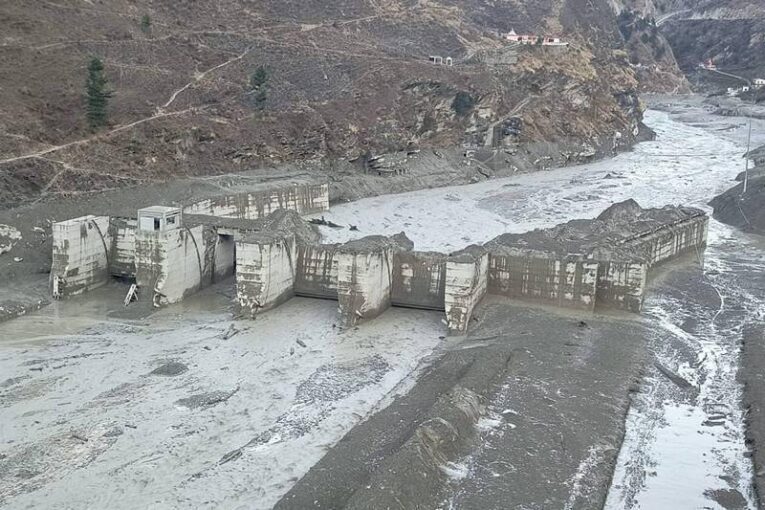
By Shweta Tyagi, Chief Functionary, India Water Foundation
In a tragic turn of events in Uttarakhand’s Chamoli district, the Nandadevi glacier broke earlier today, washing away houses near the Dhauliganga river. Over 100 are missing as rescue operations are underway. Hundreds of Indo-Tibetan Border Police personnel have been deployed for rescue operations. Water sports and activities have been stopped in Rishikesh and Haridwar is on flood alert. This catastrophe is likely to have killed around 100-150 people. The flash flood also affected the downstream hydro project NTPC at Tapovan on the river Dhauli Ganga, which is a tributary of River Alaknanda. India Water Foundation has been time and again writing to the Government of Uttarakhand to devise a robust early warning system and embrace Climate risk reduction practices to avert these kinds of natural disasters.There is a need for detailed district-level climate risk assessments, enhancing adaptive and resilience capacities and crucial to include communities in risk assessment planning as they are the worst affected by these kinds of tragedies.
Calling the glacial burst in Uttarakhand a “very rare incident”, scientists on Sunday said satellite and Google Earth images did not show a glacial lake near the region, but there was a possibility of ‘water pockets’ (lakes inside the glaciers) which might have burst, leading to this extreme event even as the entire Hindu-Kush Himalayan region has emerged as a climate change hotspot over the years said Mohammed Farooq Azam, assistant professor, glaciology and hydrology, IIT Indore. He, however, did not rule out the possibility of a snow avalanche-induced landslide. “Our understanding is also evolving. There is no doubt that global warming has resulted in warming of the region,” Azam said.

“There was a hanging glacier on the peak and at the top head of this hanging glacier, there was a huge rock mass,” Due to freezing, thawing and temperature variation, the rock mass loosened and came down, creating pressure on the hanging part of the glacier” the Wadia Institute of Himalayan Geology has said.Over 85 per cent of districts in Uttarakhand, which are home to over 9 million people, are hotspots of extreme floods and its associated events. The frequency and intensity of extreme flood events in Uttarakhand have increased four-fold since 1970. Similarly, associated flood events such as landslides, cloud bursts, glacial lake outbursts, etc. have also increased four-fold during this period, causing massive loss and damage. The state’s Chamoli, Haridwar, Nainital, Pithoragarh, and Uttarkashi districts are the most vulnerable to extreme floods.According to a report released by the Ministry of Earth Sciences last year, the Hindu Kush Himalayas experienced a temperature rise of about 1.3°C during 1951–2014. The increase in temperature has led to micro climatic changes and faster glacial retreat in Uttarakhand, thereby triggering frequent and recurrent flash floods. In the coming years, this could also impact 32 major ongoing infrastructure projects in the state, worth more than INR 150 crores each.
This appears to be a glacial lake outburst which got triggered from Rishiganga glacier catchment area, causing damage to the property and people working in dam/ tunnel sites, said Dr. Akhilesh Gupta, a senior scientist at the Department of Science and Technology, who looks after the Indian national mission on climate change in the Himalayas. Even though it may take time to find out the exact cause behind the disaster, the massive flood possibly caused by the glacial outburst in Uttarakhand once again puts the spotlight on the ecological fragility of the hill state, which faces multiple climate change threats on one hand while battling the consequences of large-scale development work on the other.It is a further proof that the climate crisis can no longer be ignored. In the last 20 years, Uttarakhand has lost more than 50,000 hectares of forest cover, leading to micro climatic changes in the region. This in turn has triggered a rise in extreme climate events in the state. A focus on land use-based forest restoration could not only reverse the climate imbalance but also help promote sustainable tourism in the state.

New research has found a global warming fingerprint on the melting glacier threatening to send an outburst flood. Not all the water from the planet’s melting glaciers is pouring into rivers and oceans. A surprising amount is building up behind unstable piles of rubble left behind by the retreating ice. As the Earth continues to warm, the swelling lakes threaten to burst through the glacial moraines holding them back and wash away the forests, towns and farms below. “The ongoing and frightening, deadly flood risk is indeed a consequence of human influence on the climate,” said University of Oxford climate researcher. The retreat of mountain glaciers is one of the clearest signs of climate change. Outburst floods threaten communities in many mountainous regions, but this risk is particularly severe in countries like India, Nepal and Bhutan, where vulnerable populations live in the path of the potential floodwaters.Along with a rise in extreme flood events the droughts have increased two-fold in Uttarakhand since 1970 and more than 69 per cent of districts in the state were vulnerable to it. Also, in the last decade, floods and drought occurred simultaneously in the districts of Almora, Nainital, and Pithoragarh. This further complicates risk-informed decision making for policymakers and response teams. A 2015 report on climate risk assessment had indicated a six-fold increase in flood frequency in the Ganga basin, over the course of the century, on a high emissions pathway. Another study published in 2020 had found that 75 per cent districts and half of India’s population were vulnerable to extreme climate events.
With the rising frequency of extreme climate events, India needs to urgently develop a nationwide real-time digital emergency surveillance and management system. Equally important is climate proofing of infrastructure, investments, and policies. Tackling of such extreme events and ensuring minimal loss and damage should be considered as a national imperative because this is costing lives, livelihoods and billions in infrastructure damage. The pathway to economic prosperity and human development should be climate resilient and environmentally sustainable.




